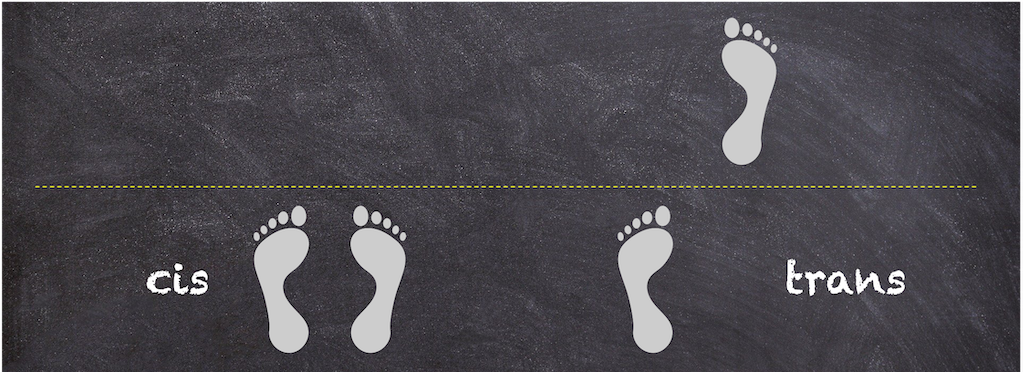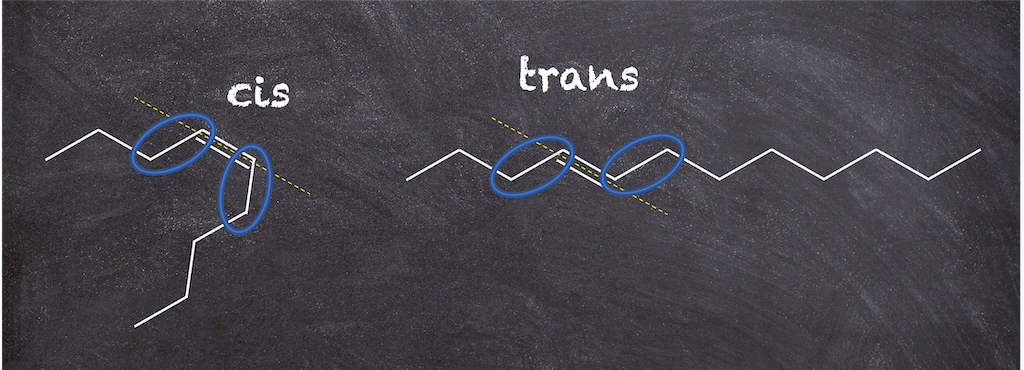In 2015, the Oxford English Dictionary added the word “cisgender” to its ever-evolving listing. It defines the adjective as “designating a person whose sense of personal identity and gender corresponds to his or her sex at birth” and is contrasted with “transgender.”
The “cis-” prefix—pronounced “sis”—was not manufactured by some progressive think-tank the year before, as some might believe. Its origin is much older, acting as the yin to the much more popular trans’ yang. Our vocabulary has been suffused with the prefix “trans-,” from “transaction” to “Transylvania.” Its sibling has shied away from the English language by comparison, with one notable exception: the scientific world.
Cis-ter molecules in chemistry
Nature provides fascinating examples of how to multiply what you can do with a limited set of building blocks. For example, two molecules can have the exact same formula—the same atoms in the same order—and yet behave very differently. That is because the orientation of these atoms in three-dimensional space is a distinct property. If we were to flatten these two molecules onto a line, they would be identical, but fluffing them up in space would show their difference.
Let’s take these two molecules.

At their core is a pair of carbon atoms with a double bond. Think of you and your friend, standing in front of each other. You grab their left arm with your left hand. You grab their right arm with your right hand. You have a solid double bond.
On either side of this double bond, there is a methyl group, consisting of a carbon atom surrounded by hydrogen atoms. But in the first molecule, both methyl groups are on the same side of the double bond, whereas in the second molecule, they are on opposite sides. Up, up versus down, up.
Both molecules are called 2-butene, but the fact that their methyl groups point in different directions must also be specified. In Latin, trans means “on the other side of,” “across,” “beyond.” Transylvania means “beyond the forest.” Transatlantic means “across the Atlantic Ocean.” And the molecule on the right is known as trans-2-butene, because its methyl groups are on different sides of the double bond.
Which means that the molecule on the left is cis-2-butene, where cis means “on this side.” If both of your feet are on the same side of a line, they are in the cis configuration. Move one of them across the line and you have achieved the trans configuration.

You may not think that molecules doing the hokey pokey would amount to much, but it does. The fuss over trans fats boiled down to “up, up” good, “down, up” not so good.
Fatty acids can be said to be saturated when their carbon atoms are bound to as many hydrogen atoms as they can handle. When some of these hydrogens are shed, it allows the carbon atoms to form double bonds with each other, and that’s where we get to the heart of the matter. In the meat and milk of cows, these double bonds tend to be in the cis configuration. It creates kinks in the chain, like a centipede going through an obstacle course. Trans fats do occur naturally, though they are not common, but problems arose when we started to artificially create them for margarine by a process known as partial hydrogenation, flipping cis bonds into trans bonds because it was more energetically favourable at the molecular level.

Consumption of these trans fats—identical to their cis counterparts except for spatial orientation—has been tied to health problems like cardiovascular disease. It seems that something as simple as a kink in the molecule can impact how the fat is taken up and metabolized by our body. (Trans fats have effectively been banned in many countries, including Canada and the United States.)
But inside our body, there is another way that the prefixes “cis-” and “trans-” can be applied, and it has to do with the molecule of life, DNA.
A cis-tem to turn genes on and off
Our genes need to be regulated. Unfettered, they would churn out mountains of proteins, like an overeager baker stacking cakes in piles all over the house. Baking needs to take into account demand. Likewise, the expression of a gene—meaning the activation of the machinery that will turn its sequence of letters from a blueprint into a fully realized protein—waxes and wanes over time. And that’s where “cis-” and “trans-” come into play.
We can imagine our DNA molecule as one long string and a gene as one stretch of that string. When that stretch is read by the right machinery, the corresponding protein will be made. But on either side of that important stretch are equally important docking sites. When the correct molecule finds its docking site, like a key fitting into the right lock, it serves as either an all-clear signal for the gene to be turned on or as a pause signal. On switch or off switch, green light or stop sign. This is one of the main ways in which gene expression is carefully regulated.
The molecules binding to these docking sites are known as trans-acting elements. The word “element” here is not related to what we see in the periodic table of elements, like hydrogen and helium. It is used in the broader sense of a part. These trans-acting elements are encoded by other bits of DNA, often far away, so these molecules come from the great “beyond” that the word “trans” conjures up. And the docking sites they bind to, the ones on the same strand of DNA as the gene they regulate, are of course known as cis-acting elements. Regulation is achieved by trans-acting elements binding to cis-acting elements.
The prefix “cis-” has thus made its way from Latin to geography—“cisalpine” meaning “on our side of the Alps”—from chemistry to chemotherapy—cisplatin being an anticancer drug whose ammine groups are on the same side of its platinum atom—from molecular biology to how we understand the complex reality of sex and gender.
The world is a complicated place. Words help make sense of it.
Take-home message:
-The prefix “cis-” comes from the Latin meaning “on this side,” as opposed to “trans-” which means “on the other side of” or “beyond.”
-In chemistry, the prefix “cis-” is added to the name of a molecule when two atoms or groups are situated on the same side of a plane of symmetry passing through the molecule, like a double bond between two carbon atoms.
-In molecular biology, a cis-acting element regulates a neighbouring gene when it binds to a trans-acting element.







